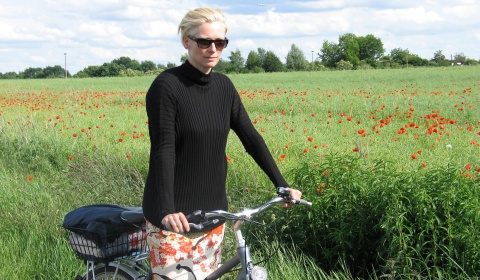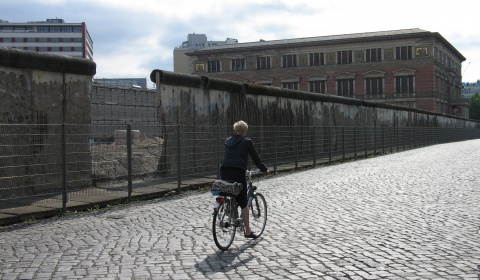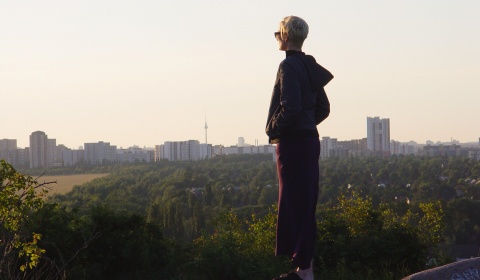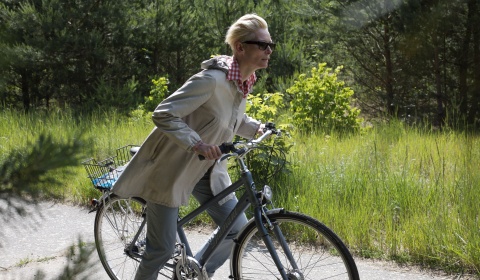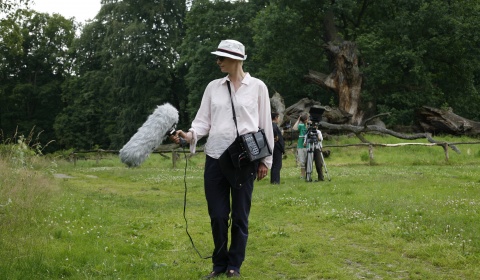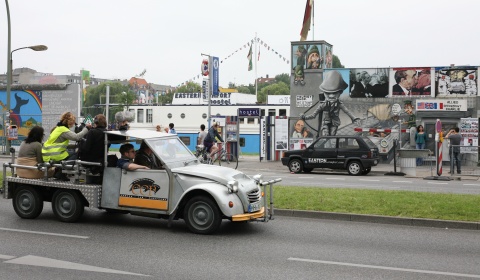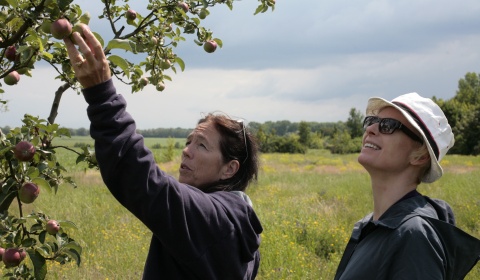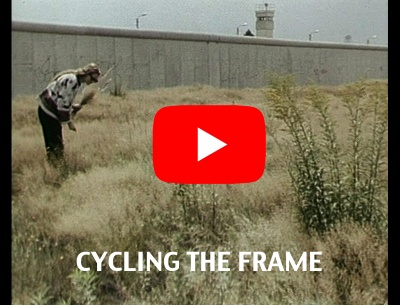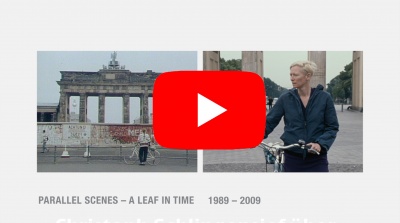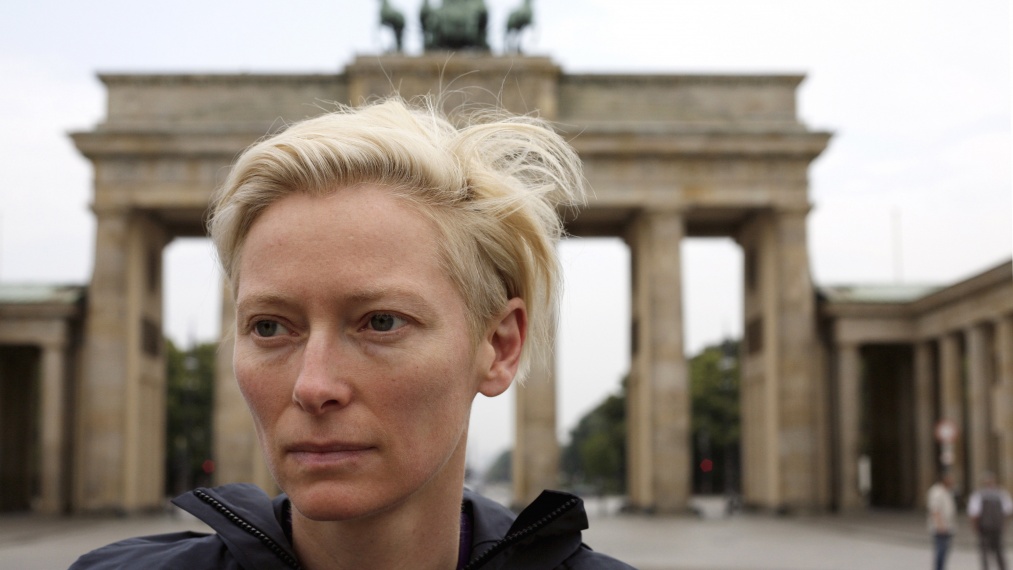
The invisible Frame
GER 2009, 60 min
Reframing CYCLING THE FRAME. Cynthia Beatt and Tilda Swinton once again go on the trail of the Berlin Wall.
Synopsis
In 1988, the British director Cynthia Beatt, who is based in Berlin, conceived a special cinematic bike tour. She selected a number of places along the 160 km long border where the young Tilda Swinton cycled along and thus apparently circled the island of West Berlin once. Today CYCLING THE FRAME is a rare historic document and Tilda Swinton is one of the world’s most admired performers.
In June 2009, Cynthia Beatt and Tilda Swinton re-traced the line of the Wall that once isolated Berlin from East and West Germany. THE INVISIBLE FRAME describes this journey, a Wall’s fall and 21 years later, through varied landscapes, this time on both sides of the former Wall. The stagnation of organic growth that characterized the areas separated by the Wall, is now replaced by unchecked nature and building development. The rhythmic interaction of fixed camera and tracking shots combine in a vibrant orbiting of Berlin, visually intertwining west and east. Tilda Swinton’s personal reflections are integrated as inner monologues and complete the film’s soundscape composed by Simon Fisher Turner, who collaborated with Derek Jarman and Tilda Swinton in the 80’s.
Streaming-Info
Rent or buy the movie on our Vimeo channel. For other providers, see “Watch Movie”.
Language: English, Subtitles: Arabic, German, English, French, Persian, Portuguese, Spanish
Film kaufen
VOD
451-Vimeo
amazon
DVD
451-Alive Shop
amazon
Press reviews
Tilda Swinton’s discrete and yet intense performance, her trenchant reflections that elude rigid thought patterns and unfurl in a moment of poetic freedom, allow the audience associative space and enables them to re-consider and newly perceive the disappearance of the Wall The filmic shots attain an almost haptic quality through the interplay of the world of images created by static camera and fluid travelling shots with the sound wall that congenially underlies the original sound, allowing the audience to sense the tangible pleasure of this motion through the open landscape – and thus conveys how very much Berlin has changed. (Angelika Ramlow, FriedlicheRevolution.de)
The movements, reflections and banalities co-exist peacefully within the measured flow of images and thoughts – which is not only comforting, but rather allows a deeply genuine approach to the difficult penning of the united Germanys. [...] Cycling the Frame and The Invisible Frame are psycho-geographic, philosophical meditations. (Anke Westphal, Berliner Zeitung)
Awards and Festivals
- Viennale 2009
- KunstFilmBiennale Köln 2009
- Deutsche Geschichten Theaterfestival Leipzig 2009
- Glasgow Film Festival 2010
- Thessaloniki Documentary Festival 2010
- Festival du cinéma de Brive 2010
- Achtung Berlin Film Festival 2010
- Pesaro Film Festival 2010
- Festival des deutschen Films 2010
- Split Film Festival 2010
- Darb 1718 in Cairo 2013
- Nürnberger Fahrrad-Film-Festival 2015
- Festival of Cultures of European Regions in Poland 2016
- Vilnius Documentary Film Festival 2017
- Kunsthalle Bahnitz 2019
- Valencia International Film Festival - Cinema Jove 2019
- Hamburger Bahnhof Berlin 2019
- Festival de Cine México Alemania CineMA
Additional Texts
The mechanism of this repeated journey afforded us the opportunity to meditate freely on the whole concept of borders, history, adaptation, natural cycles of development and a host of other conceptual and existential territories. (Tilda Swinton)
Katja Petrowskaja talks to Cynthia Beatt about her films CYCLING THE FRAME and THE INVISIBLE FRAME (2009)
How did the original idea for your first film, CYCLING THE FRAME come about?
I had been in Berlin for 12 years and lived at the top of an old factory building near the Potsdamer Platz. I looked out my windows at the ruins left standing after the war. From my terrace I could see the soldiers in the watchtower. The ruins and the Wall were my immediate neighbours. The inconceivability of the Wall was always present. One lived with it, but was quietly horrified by it and disbelieving.
The desire to follow the Wall was there before I had the idea to make the film. I made the whole tour and understood for the first time what the Wall really was, what it meant. I comprehended that we lived on an island within the German Democratic Republic (GDR), to physically circumvent the island was a revelation.
You travelled the entire 160 km of the Wall?
Yes, and was fascinated by the outward and inward perspectives. Berlin had grown outwards by integrating villages and land, an organic process, but the Wall stopped that. In 1988 I gazed from the fields near Lubars (in north-east Berlin) at another little village on the East side and realised that this was where Berlin could no longer advance. I was drawn to this standstill situation as I rode along the Wall.
I often went to East Berlin, but you couldn’t get close to the Wall on that side, or film it, you would be arrested.
How did the film come about?
I’m constantly visualizing my ideas as films, all my material inevitably develops into film concepts. In the spring of 1988, Carola Wedel from the SFB asked me to suggest something for a series made by non-Germans called “Looking from the Outside”. I suggested biking along the Wall with Tilda as the cyclist.
How did you win Tilda Swinton for the project? That was a couple of years after she had played in Jarman’s film CARAVAGGIO.
Derek Jarman was an old friend and I met Tilda through him. She and I had already done some work together. We’d worked on developing my Fiji script and I wanted her to play the main part.
Tilda rides a bicycle in the first film and the recent one. Why a bicycle?
It was an ideal way to follow the Wall. You sit and travel in a direction, your head is free, you can take your time or speed along, and your thoughts flow with you. The blood is pumping through your body. It’s mentally and physically stimulating. And, above all, you’re free. The film has something to do with a pilgrimage, setting oneself a final destination and then taking it day by day.
And this second film, was it a remake?
No. For me it was perfectly clear: this film is not a repeat, a remake, a sequel. It had to stand independently of the first film. Tilda expressed it eloquently: the print of a second foot, twenty years and a wall's fall later.
While researching the first film I would imagine the Wall coming down while I rode my bike. On the one hand it was a wonderful fantasy. The two Germanys come together. But what happens then? A couple of generations had been born on either side of the Wall who had little or no contact with each other. One side living under a repressive regime where the Wall was called the “anti-fascist protection Wall” and the other side growing up in a liberal, capitalist society.
The second film was to have been made 10 years after the first film. But Tilda had her young twins. So I shot a rehearsal with a Welsh filmmaker, Nia Dryhurst, she doubled for Tilda. I filmed with Hi8, - riding the bike with one hand, the camera in the other. In early 2009 I had the feeling it might be possible. I spoke to Carola Wedel and she was excited by the idea, but couldn’t produce it. I wrote to Tilda asking whether she’d like to do another bike trip in Berlin. She answered immediately: Yes! Then Inge Classen, a great commissioning editor for 3sat, came in. And I finally made the connection to Frieder Schlaich and Irene von Alberti of the Filmgalerie 451. Frieder is an unusual producer, he made everything possible.
What differences are there between the first and second film? The first was with the Wall and when you shot the second, the Wall was long gone. You travelled along the line of the former Wall, but there was nothing to see?
If you look closely there is a lot to see, but it is not easy to define or to put words to. It was instinctive ghost work. I had done a good deal of research into the process of coming to terms with the Nazi past, and I was very involved with the question of how that affects contemporary Germany. There are many countries that have never been involved in such a process. Germany is way ahead of them in a most positive sense (look at Italy!), sensitised to the dangers of fascist tendencies. This research continued for the second film, digging under the surface of reunification.
There is also a political background. I grew up in the former British colonies. I watched the ‘takeover’ of the GDR with some dismay. It reminded me of the condescension in offering a system that one considers superior. There was no question whether the citizens of the GDR had anything to offer us.
What were you looking for?
I was wired-up to see what I would find. I wasn’t just looking for the real remains of the Wall, nor for monuments or memorials, though they were of course important – people who were killed attempting to escape stand for all those who were oppressed and degraded by the Wall. But the film was also a search for what is emerging, and developing on this Wall-strip. The closer you look the more detailed the findings.
I had to decide: do we go anti-clockwise this time? Do we film in the same locations? Some thought I should edit in footage from the first film… A few locations happened to be the same as in the first film, or close, because they were in the former East, on the other side of the Wall-line. Naturally I stumbled on places where I had filmed before, some of which I didn’t recognize immediately.
My decision was to make a weaving movement along the old Wall line, on the line of separation, as if sewing the two sides together. It is allegorical. One understands this unconsciously, in one’s heart, the wish to heal this wound.
Is this weaving a ritual? One weaves the sides together, but now with new media.
I didn’t think of it as a ritual, but it is a pertinent description.
Tilda was looking at her own film-future 20 years ago.
Yes. In the first film Tilda looks over the Wall towards the ‘East’, in the second she stands in some of the places she gazed at in CYCLING THE FRAME. She cycles along the death strip, she enters the factory, stands by the Heiland Church in Sacrow.
Tilda is the performer, but she is also herself. What did each of you bring to the film?
I researched the entire route for weeks with the camerawoman (Ute Freund) and chose the locations. I needed to set points along the way, but avoid a banal representation of sections along the circumference. When the team arrived at a location, depending on the time of day or unexpected goings-on (people, traffic, etc.), I had to concentrate on what was central to that particular shot and quickly find a way to cinematically capture the essence of the place, as well as to determine what Tilda needed to do. And Tilda responded to the given situation in a very fine way and through that something new and spontaneous arose.
What did Tilda bring to the film?
Tilda has a keen sense of rhythm and timing, a feeling for the camera and a lovely playfulness and irony, a Buster Keaton facet, which she brought to the film. I trusted that, within the framework Ute and I could offer her, she would respond with ingenuity. It’s a process of complementing each other.
Did you create a space and framework for her where she could move freely? Or was it constantly discussed and newly defined?
More the latter. Moving freely would have meant making a documentary about the private person Tilda Swinton riding along the ghost Wall, which it most certainly isn’t. We shot the film in 18 days, that’s not a lot of time to cover 160 km, and we usually had to rehearse and do several takes. We’d arrive at the next location, suss it out, then set up the shot and work it out with Tilda, shoot, then on to the next location. We shot about 5-9 scenes a day, some pretty complex in terms of rehearsals to coordinate the camera and moving vehicle with Tilda on the bike, a choreography of cyclist and camera. Each location was approached differently.
There is a moment in the film when Tilda rides right along the former Wall line. On the cobblestones. She weaves from one side to the other. What is the border for you today?
I‘m still aware of nearing or crossing the former border, of being in the East. One had internalized it geographically. It remains a line of psychic demarcation.
How did the film texts originate?
Tilda suggested two poems, one by the Russian poetess Anna Akhmatowa and the other by Yeats “The Isle of Innisfree”. Then came excerpts from “An Apology for Idlers” by Robert Louis Stevenson, which I had shown to Tilda many years ago and she now brought back to me. We taped several passages from that little essay, but only one found a place in the film.
The other texts came from Tilda. To a certain extent they emerged from a discussion between Tilda, Simon and myself on the day we went into the sound studio. The poetic free-flowing thoughts, or for example, the list of things-to-do, were improvised by Tilda. While riding a bike one naturally considers the backlog of tasks. Thoughts flow in and out. They weave their way through one’s mind and interact with what one sees along the way.
Simon Fisher Turner taped sound along the Wall line. He worked on them for the ‘soundscape’, as well as on several music sequences. I saw, however, that this film couldn’t carry sound in the same way as the first film, nor could I lay down a lot of text. The poems were perfect for the scenes we’d imagined them for. But each text passage needed time and space to allow the words to resound in the ears and hearts of the audience, not just in proximity to that one scene, but in the context of the entire film. I wanted the audience to sense things without being too explicit, no explanations. I needed to transpose the choreography of sound, text and movement that I held in my imagination, to make it real, to carry the audience. The film went its own way and became something that I didn’t consciously set out to make. I like that. The essence is there and somehow deeply familiar, but the result is still surprising.
Were there surprises?
It surprised me to see a poppy field where once there had been the death strip, that was one of the most exhilarating moments. Also to see again how different the outer suburbs are in comparison to the center. Kreuzberg, where I live, or Mitte and Prenzlauerberg are just a small part of this city, one aspect. It’s rewarding to have a greater sense of the city. It’s tragic, however, that so little remains of the Wall; the few remaining pieces are generally run down or simply kitsch. Then one arrives in Rudow to find a length of Wall behind bars, as if in a cage, or better said, a caged Wall, like an animal threatened with extinction, which needs to be protected. That surprised me.
Near the end of the film somewhere, Tilda says that it is a lonely decision to live without fear, with an open heart.
Tilda was slightly apprehensive that the audience might think her arrogant. As if she were saying, look at me, I have succeeded in being fearless. But it is clear to me that she is in the process. She recognizes how fear damages us. She says, people lay down their arms in the presence of a fearless heart, and that is a wonderful thought. That is something that distinguishes Tilda. One sees she intends to take this path in life and it’s one reason why people love her, because they feel this.
There is a moment that disturbed me a little. There is a lot being done about the Wall theme, a lot of it is superficial, but there is much heartfelt and thorough research. But in the film, near the watchtower, where there is now a museum, Tilda says that it has all disappeared and a carpet rolled over it. Is that not too strong?
It was much more concrete. Yes, the city and television are now full of information related to the fall of the Wall. But much of the information has had to be fought for. It isn’t just handed out. We saw a very tiny room in the watchtower. We didn’t know what it had been used for, a cell, perhaps for those who attempted to escape and been caught, and we asked the people looking after the museum. They had tried to get in touch with former guards who had done duty there, but no one responded to their enquiries. They found not one single person willing to speak about it - of all the hundreds of men who’d done duty there. That’s what Tilda meant. Generally speaking, she is right. Why must we do all the work? There was a great deal learnt after the second world war about coming to terms with the past, with one’s own history. An endless process and within the next decade more will emerge. One has to seek out the discussion. I spoke to the men working in the Borsig factory - it was simply incredible, the stories that come to light, about compulsory relocation of families, for instance, some of the things they lived through during the GDR era. And I think, 90% of former West Germans still know very little.
Is it a film about walls?
Indirectly, yes. It is about the transience of walls and the fact that they achieve nothing, except to create more negativity. The film has many strata. I can’t say that the film is about something. Matisse felt that the human side of painting is the result of a mysterious, expressive quality which, if the painter is possessed of a good sensibility, comes through in the final painting. Thus it need not be overly stated in the subject matter….” He was referring to paintings, but I apply it to cinema. It is about perception. I like films that have a deceptive lightness, with underlying layers of consciousness, images, sound. Film is like music. In a sense, I compose my films as “musical scores”.
Galerie Extras
Set photos from the film shooting of THE INVISIBLE FRAME. "We shot the film in 18 days, that’s not a lot of time to cover 160 km, and we usually had to rehearse and do several takes. We’d arrive at the next location, suss it out, then set up the shot and work it out with Tilda, shoot, then on to the next location. We shot about 5-9 scenes a day, some pretty complex in terms of rehearsals to coordinate the camera and moving vehicle with Tilda on the bike, a choreography of cyclist and camera. Each location was approached differently." Cynthia Beatt
Video Extra
CYCLING THE FRAME by Cynthia Beatt (GER 1988, 27 min)
PARALLEL SCENES 1988/2009 - CYCLING THE FRAME and THE INVISIBLE FRAME von Cynthia Beatt
Watch Movie
VOD
451-Vimeo
amazon
DVD
451-Alive Shop
amazon
Credits
Director
Cynthia Beatt
With
Tilda Swinton
Director of Photography
Ute Freund
Assistant Camera
Markus Otto
Grip
Nico Storch, Matthias Maaß, Mathieu Rech
Set Photographers
Sandro Kopp, Robert Brecko
Editor
Dörte Völz
Assistant Editor
Kolja Kunt
Original Sound
Frank Kruse
Soundscape
Simon Fisher Turner
Sound Design
Jochen Jezussek
Sound Mix
Matthias Lempert
Assistant Director
Johannes Blume
Set Manager
Roman Savary
Production Manager
Sabine Steyer
Producer
Frieder Schlaich
Produced by
Filmgalerie 451
In Coproduction with
ZDF/3sat (Inge Classen)
In Cooperation with
Goethe-Institut London und Auswärtiges Amt
Funded by
Medienboard Berlin-Brandenburg
World Premiere
24.10.2009, Vienna, Viennale
German Theatrical Release
06.11.2009
DVD-Details
Extras
CYCLING THE FRAME by Cynthia Beatt (GER 1988, 27 min), “Parallel Scenes 1988/2009” scenes from both films compared, “Recording Session” Cynthia Beatt, Tilda Swinton, Simon Fisher Turner and Frank Kruse at the Sound Studio (7min)
Language
English
Subtitles
English, Arabic, German, Spanish, French, Portuguese, Russian
Country Code
Code-free
System
PAL / Color
Aspect Ratio
(Super 16, 1:1,66) / 16:9
Sound Format
DD 5.1
Content
Softbox (Set Content: 1)
Release Date
06.11.2009
Rating
Info-Programm gemäß §14 JuSchG
Distribution Details
Screening Format
DCP (2K, 25 fps, 5.1)
Blu-ray Disc
Language
English
Subtitles
German
Aspect Ratio
16:9
Promotion Material
A1 poster, Trailer
License Area
Worldwide, except US
Rating
Info-Programm gemäß §14 JuSchG


